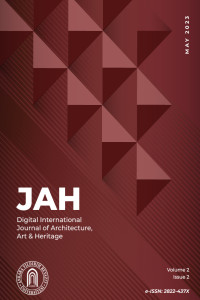Öz
Kaynakça
- Aksüt, A. (1932). Erzincan Tarihi. İstanbul: Illustrated moon printing house.
- Aktepe, O. (2009). Terzi Baba'nın İtikadi Görüşleri. Erzincan: Ermat Publishing.
- Albayrak, N. (1983). Folklorumuz ve Erzincan. Erzincan: Ermat Publishing.
- Albayrak, N. (2011). Terzi Baba. Turkish Religious Foundation Encyclopedia of Islam.
- Arkiv. (tarih yok). Erzincan Terzibaba Camii ve Külliyesi. https://www.arkiv.com.tr/proje/erzincan-terzibaba-camii-ve-kulliyesi/6576
- Aşkun, V. C. (1956). Terzi Baba ve Erzincan Şairleri. Balıkesir: Turkish language printing house.
- Aydın, D., & Büyükşahin, S. (2017). Son Dönem Konya Camilerinde Biçimsel Arayışın Analizi. Türkish - Islamic Civilization Academic Research Journal, 12(24), 67-84.
- Bezgin, Y. K. (2019). Erzincan İli ve Çevresinde Bulunan Ziyaret Yerleri Etrafında Oluşan Halk İnanmaları. Doctoral dissertation. Ankara: Yıldırım Beyazıt University Institute of Social Sciences.
- Duysak, N. (2000). 20. Yüzyıl Türkiye'sinde Cami Tasarımı ve Geleneksel Cami. Master Thesis. Istanbul: Istanbul Technical University Institute of Science and Technology.
- İnbaşı, M. (2009). Erzincan Kazası (According to the Avarız Register dated 1642). Journal of Atatürk University Institute of Turkish Studies(41), 189-214.
- Kansu, M. A. (2013, April 11). Terzi Baba Camisi - Erzincan'ın Modern Yapısı. kansudan.blogspot.com: http://kansudan.blogspot.com/2013/04/erzincanda-modern-terzibaba-camisi.html
- Kaplan, S. (2019, May 16). Doğu Anadolu'nun En Büyük Camisi 10.000 Kişiye Hizmet Veriyor. https://gundem24.com.tr/dogu-anadolunun-en-buyuk-camisi-10-000-kisiye-hizmet-veriyor/
- Karaman, F. (1991). 13 Mart 1992 Erzincan Depremi ve Camilerimiz. Journal of Diyanet(7), 13-14 and 40.
- Kaya, T. (2001). Dünden Bugüne Erzincan'da Halk Kültürü. Erdem, 13(38), 271-294.
- Miroğlu, İ. (1995). Erzincan, In Turkish Religious Foundation Encyclopedia of Islam (Cilt 11). Turkey Diyanet Foundation Publications.
- Naldan, F. (2019a). Eski Erzincan Şehri Camileri. Mediterranean Art(13), 355-370.
- Naldan, F. (2019b). Erzincan İli Cami Mimarisi. Doctoral dissertation. Ankara: Gazi University Institute of Social Sciences.
- Özgüç, T. (1969). Altıntepe I, II. Ankara.
- Öztürk, S. (1977). Erzincan İli ve İlçeleri Yakın Çevre İncelemesi. Erzincan: Özsoy Printing House.
- Tahir, M. (1333). Osmanlı Müellifleri (Cilt 1). İstanbul: Amire printing house.
- Yurt, V. (2011). Terzi Baba ve Erzincan (İki Küre). İstanbul: Birun Culture and Art Publishing.
HISTORY AND ARCHITECTURAL IMPLEMENTATION OF TERZI BABA MOSQUE AS A SYMBOLIC STRUCTURE/VALUE OF ERZINCAN
Öz
In Anatolia, especially in the mosques built after the 20th century, the search for different forms from the old periods and modern designs that change in terms of architecture come to the fore. Terzi Baba Mosque, which has become one of the symbols of Erzincan province in Eastern Anatolia, is a structure that can be considered in this sense. The project construction of Terzi Baba Mosque, designed by the architect Danyal Tevfik Çiper (1932 – 2008), started in 1990. Its foundation was laid in 1991 and it was opened to worship in 2002. The building, which has a congregation capacity of approximately 7000 people, has taken its place in the literature as the largest mosque in Eastern Anatolia.
The aim of the study is to reveal the architectural features of the symbolic mosque of Erzincan, which was designed by Tevfik Çiper, who designed many different and modern building designs at the time it was made, and which was not adopted by the public at first, but which is appreciated by both the local people and those who visit from other cities. As a research method, data analysis obtained as a result of on-site observation, spatial analysis and periodic comparisons was used. Although it has been the subject of several studies and theses, these researches remained superficial, application details and spatial transformations were not discussed. In this sense, it is thought that the study will contribute to the literature on the architectural construction features of the mosque and the differences in practice.
Anahtar Kelimeler
Terzi Baba Mosque architectural project modern mosque architecture architectural practice spatial transformation
Kaynakça
- Aksüt, A. (1932). Erzincan Tarihi. İstanbul: Illustrated moon printing house.
- Aktepe, O. (2009). Terzi Baba'nın İtikadi Görüşleri. Erzincan: Ermat Publishing.
- Albayrak, N. (1983). Folklorumuz ve Erzincan. Erzincan: Ermat Publishing.
- Albayrak, N. (2011). Terzi Baba. Turkish Religious Foundation Encyclopedia of Islam.
- Arkiv. (tarih yok). Erzincan Terzibaba Camii ve Külliyesi. https://www.arkiv.com.tr/proje/erzincan-terzibaba-camii-ve-kulliyesi/6576
- Aşkun, V. C. (1956). Terzi Baba ve Erzincan Şairleri. Balıkesir: Turkish language printing house.
- Aydın, D., & Büyükşahin, S. (2017). Son Dönem Konya Camilerinde Biçimsel Arayışın Analizi. Türkish - Islamic Civilization Academic Research Journal, 12(24), 67-84.
- Bezgin, Y. K. (2019). Erzincan İli ve Çevresinde Bulunan Ziyaret Yerleri Etrafında Oluşan Halk İnanmaları. Doctoral dissertation. Ankara: Yıldırım Beyazıt University Institute of Social Sciences.
- Duysak, N. (2000). 20. Yüzyıl Türkiye'sinde Cami Tasarımı ve Geleneksel Cami. Master Thesis. Istanbul: Istanbul Technical University Institute of Science and Technology.
- İnbaşı, M. (2009). Erzincan Kazası (According to the Avarız Register dated 1642). Journal of Atatürk University Institute of Turkish Studies(41), 189-214.
- Kansu, M. A. (2013, April 11). Terzi Baba Camisi - Erzincan'ın Modern Yapısı. kansudan.blogspot.com: http://kansudan.blogspot.com/2013/04/erzincanda-modern-terzibaba-camisi.html
- Kaplan, S. (2019, May 16). Doğu Anadolu'nun En Büyük Camisi 10.000 Kişiye Hizmet Veriyor. https://gundem24.com.tr/dogu-anadolunun-en-buyuk-camisi-10-000-kisiye-hizmet-veriyor/
- Karaman, F. (1991). 13 Mart 1992 Erzincan Depremi ve Camilerimiz. Journal of Diyanet(7), 13-14 and 40.
- Kaya, T. (2001). Dünden Bugüne Erzincan'da Halk Kültürü. Erdem, 13(38), 271-294.
- Miroğlu, İ. (1995). Erzincan, In Turkish Religious Foundation Encyclopedia of Islam (Cilt 11). Turkey Diyanet Foundation Publications.
- Naldan, F. (2019a). Eski Erzincan Şehri Camileri. Mediterranean Art(13), 355-370.
- Naldan, F. (2019b). Erzincan İli Cami Mimarisi. Doctoral dissertation. Ankara: Gazi University Institute of Social Sciences.
- Özgüç, T. (1969). Altıntepe I, II. Ankara.
- Öztürk, S. (1977). Erzincan İli ve İlçeleri Yakın Çevre İncelemesi. Erzincan: Özsoy Printing House.
- Tahir, M. (1333). Osmanlı Müellifleri (Cilt 1). İstanbul: Amire printing house.
- Yurt, V. (2011). Terzi Baba ve Erzincan (İki Küre). İstanbul: Birun Culture and Art Publishing.
Ayrıntılar
| Birincil Dil | İngilizce |
|---|---|
| Konular | Mimarlık |
| Bölüm | Conference paper |
| Yazarlar | |
| Yayımlanma Tarihi | 25 Mayıs 2023 |
| Gönderilme Tarihi | 14 Ekim 2022 |
| Yayımlandığı Sayı | Yıl 2023 Cilt: 2 Sayı: 2 |
Creative Commons License
Digital International Journal of Architecture, Art & Heritage by https://aybu.edu.tr/jah/en is licensed under a Creative Commons Attribution-NonCommercial 4.0 International License.


